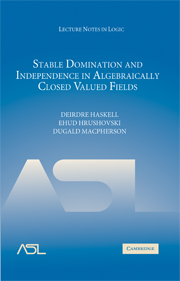CHAPTER 1 - INTRODUCTION
Published online by Cambridge University Press: 18 December 2009
Summary
As developed in, stability theory is based on the notion of an invariant type, more specifically a definable type, and the closely related theory of independence of substructures. We will review the definitions in Chapter 2 below; suffice it to recall here that an (absolutely) invariant type gives a recipe yielding, for any substructure A of any model of T, a type p│A, in a way that respects elementary maps between substructures; in general one relativizes to a set C of parameters, and considers only A containing C. Stability arose in response to questions in pure model theory, but has also provided effective tools for the analysis of algebraic and geometric structures. The theories of algebraically and differentially closed fields are stable, and the stability-theoretic analysis of types in these theories provides considerable information about algebraic and differential-algebraic varieties. The model companion of the theory of fields with an automorphism is not quite stable, but satisfies the related hypothesis of simplicity; in an adapted form, the theory of independence remains valid and has served well in applications to difference fields and definable sets over them. On the other hand, such tools have played a rather limited role, so far, in o-minimality and its applications to real geometry.
Where do valued fields lie? Classically, local fields are viewed as closely analogous to the real numbers. We take a “geometric” point of view however, in the sense of Weil, and adopt the model completion as the setting for our study.
- Type
- Chapter
- Information
- Publisher: Cambridge University PressPrint publication year: 2007

